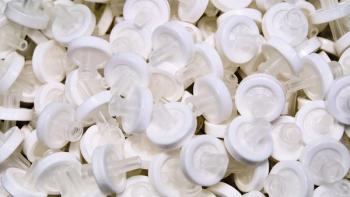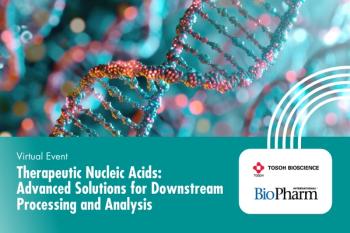
- BioPharm International-08-02-2011
- Volume 2011 Supplement
- Issue 5
Analysis of PEGylated Protein by Tetra Detection Size Exclusion Chromatography
Reliably detecting low amounts of high molecular weight impurities during process development and characterization of biopharmaceutical products.
Size exclusion chromatography (SEC) provides critical information about the purity and oligomeric state of protein therapeutic products. SEC analysis is important for process development, formulation optimization, release testing, stability, comparability, and forced degradation studies SEC coupled with light scattering (LS), ultra-violent (UV), and refractive index (RI) detection offers detailed molecular weight information about proteins, protein complexes, and glycosylated proteins (1–3). The current study uses a tetra detection system (laser light scattering, viscometer, RI, UV) coupled with software that integrates data from all detectors to analyze a model PEGylated protein. The detection system provides accurate molecular weight, intrinsic viscosity, and hydrodynamic volume with minimal input of known parameters. High molecular weight (HMW) impurities observed in different stress and process samples were characterized by this method. This study examines the major and minor species present in samples of a model PEGylated protein encountered during biopharmaceutical development.
MATERIALS AND METHODS
A model PEGylated protein was prepared for use in these studies. The protein of approximately 19 kDa was expressed in E. coli, purified, and then modified with methoxypolyethylene glycol aldehyde (mPEG) with a molecular weight of approximately 20 kDa. Samples representing process intermediates, PEGylation with different lots of mPEG, and force-degraded material were analyzed.
The Viscotek TDAmax system (Malvern Instruments) was used for the SEC analysis of the protein conjugates. This tetra detection system (TDA305) includes photodiode array UV, differential RI, right angle light scattering (RALS), low angle static light scattering (LALS) and four-capillary differential viscometer detectors. The system also includes a GPCmax VE 2001 liquid chromatography autosampler with an isocratic pump and degasser equipped with a Superdex 200 column (10 × 300 mm, GE Healthcare). The detectors were in the following order: UV, LS, RI, and viscometer. OmniSEC 4.7 software (Malvern Instruments) was used for the acquisition and analysis of SEC data.
Determination of the detector offsets, asymmetric band broadening correction, and detector constants was completed using bovine serum albumin (BSA) monomer peak in a mobile phase of PBS (150 mM phosphate and 100 mM NaCl) at 0.5 mL/min flow rate. 0.185 (1) and 0.66 (2) were used as (dn/dC) value and extinction coefficient (dA/dC or ε1% at 280 nm) of BSA, respectively. The same process was followed with the unmodified protein for comparative analysis. The dn/dC was set at 0.185 (experimentally confirmed) and the extinction coefficient (dA/dC or ε1% at 280 nm) was experimentally determined. An isocratic elution profile was used at a flow rate of 0.5 mL/min. Buffer solutions were vacuum filtered through a 0.2 µm nylon filter and degassed before use. Samples were run under the same chromatographic conditions. Injection volumes were adjusted to accommodate samples with lower protein concentrations (injection volume range = 20–100 µL).
THEORY
The light-scattering intensity of polymer molecules in solution is proportional to the molecular weight and concentration of the sample (4):
where, Rθ is the excess intensity of light scattered at angle θ, C is the sample concentration, Mw is the molecular weight, A2 is the second virial coefficient and K is an optical constant, which is proportional to (dn/dC)2. Because the concentration of the sample solution in SEC is highly dilute, A2 is often negligible:
where, P(θ) is the particle scattering function, which represents the angular dependency of light-scattering intensity and is related to radius of gyration (Rg) of the polymer molecule. Depending on the size and dissymmetry of the polymer molecule, P(θ) can take on values that are equal to, or less than unity. From these equations, intensity of the static light-scattering signal (LS) can be simplified to:
where, KLS is the instrument calibration constant and dn/dC is RI increment.
In tetra detection SEC, viscosity of the polymer solution is simultaneously measured by a four-capillary viscometer at every elution point of the chromatogram with the detector signal of (VIS):
where, [η] is intrinsic viscosity and C is the concentration of solution. The viscometer detector combined with a concentration detector, such as UV or RI, provides local intrinsic viscosity. The molecular size of the polymer at every elution volume can be calculated using the intrinsic viscosity.
The concentration detectors used in SEC tetra detection are UV and RI detectors. The UV absorbance detector works like a UV–Visible spectrophotometer. The response of the detector is as follows:
where KUV is the instrument constant and the dA/dC value is equivalent to the ε1% form of the extinction coefficient. The response of the RI detector may similarly be expressed as:
where, KRI is, again, the instrument constant.
To determine the molecular weight and the size of the target molecule, dn/dC values or concentrations of complexes must first be determined. dn/dC is assumed to be constant for native protein species. For heterogeneous protein conjugates, the dn/dC value will change as the chemical composition varies across the SEC separation. A true dn/dC value can only be obtained by direct determination of discrete dn/dC values at each chromatographic volume increment. The response of a RI detector is the sum of the responses of each species (protein + PEG) as shown (1):
When the conjugate complex is detected by two different concentration detectors, UV and RI, then two equations are obtained with two unknowns and this then can lead us to the percentage of both protein and PEG at every elution point:
dn/dC is calculated for each chromatographic volume increment with these equations and used to obtain a corrected concentration distribution. The corrected dn/dC for each chromatographic volume increment is then used to calculate the correct Mw and size. In our calculations, we used 0.185 mL/g and 0.113 mL/g for dn/dC values of protein and PEG. dA/dC values of protein and PEG were as decribed.
RESULTS AND DISCUSSION
Samples prepared with different lots of mPEG were analyzed by the tetra detector system. The unmodified model protein was also tested for comparison. Figure 1 contains a representative chromatogram noting the signal from all four detectors. Table I lists parameters obtained for the main peak. Small shifts in the Mw can be detected between lots. As noted in the table, the relative difference in Mw for the mPEG accounts for the variability in the Mw of the PEGylated protein. While the mPEG is labeled as 20 kDa, this represents a polydisperse polymer with a broad population of mPEG molecules with different chain lengths. Orthogonal testing by mass spectrometry and nuclear magnetic resonance (NMR) indicates the Mw of the material used for PEGylation ranges from approximately 20100 Da to 21500 Da (7, 8, 9). The protein content percentage for each main peak is approximately 50% as would be expected for this protein modified primarily by a single molecule of 20 kDa mPEG.
Figure 1: Tetra detector chromatogram of the PEGylated protein main peak. Detector signals shown include refractive index (red), UV at 280 nm (purple), viscometer (blue), and right angle static light scattering (green). All signals were normalized and the logMW data is shown in black to highlight the homogeneity of this native peak.
The intrinsic viscosity is measured directly whereas the hydrodynamic size is calculated from Einstein's viscosity equation, which relates intrinsic viscosity and Mw to the hydrodynamic size of an equivalent sphere. The intrinsic viscosity for the model PEGylated protein (0.228–0.240 dL/g) is similar to free PEG (0.38 dL/g) and greater than protein alone (0.034 dL/g), as expected. The measured intrinsic viscosity for BSA (0.039 dL/g) is comparable to the published value (0.037 dL/g) (5). The hydrodynamic size of the PEGylated protein increases as the mPEG of larger size was used for modification. The hydrodynamic radius for the main peaks (5.17–5.35 nm) are similar to those measured (by SEC with calibrated PEG standards) for proteins with a similar Mw modified with a single 20 kDa mPEG (6).
Table I: Comparison of model PEGylated proteins modified with different lots of mPEG1.
Repeat injections differ by less than 1% for all parameters noted in Table I. These highly reproducible results were obtained with separate calibrations using BSA or the unmodified protein.
Figure 2: Staggered overlay of the refractive index signal (a) and right angle static light scattering (RALS) signal (b) for the five stressed samples. It is clear that different applied stress conditions will impact both the concentration of oligomer and aggregate species, as well as their distribution. Note that the light scattering signal is a function of size, not necessarily abundance, especially for large aggregates.
IMPURITY ANALYSIS
A process intermediate and several forced degradation samples were analyzed by the tetra detection system (see Figure 2). Generally, two primary peaks were detected, a soluble aggregate peak near the void of the column eluting near 8 mL and a soluble oligomeric peak eluting at 10 mL, near the main peak. For the oligomer and aggregate peaks Mw information was obtained from static light scattering and the copolymer method in the OmniSEC software. Analysis of the integrated peaks is shown in Table II, along with the repeatability and precision of the measurement for the oligomer peak. Data are tight across two days of testing for a peak at 0.34% (peak area by RI). Stress by agitation, heat or extended room temperature incubation produces samples with HMW impurities with different molecular weights. The agitated sample contains a large oligomeric peak whose molecular weight is indicative of a dimer of the PEGylated protein. In addition to molecular weight, the hydrodynamic radii can be determined by this analysis.
Table II: Comparison of impurity peaks detected in model PEGylated protein samples.
The oligomer and aggregate peaks were less homogeneous than the native conjugate. The heterogeneity is numerically depicted in the polydispersity value (Mw/Mn). Visual examination of the light-scattering signal for the HMW impurities indicates differences between samples and heterogeneity in this peak. The aggregate peaks demonstrated greater variability in molecular weight and polydispersity. The intrinsic viscosity of the aggregate was unable to be reliably measured by this method. This is likely due to the small weight fraction present of these species and the inability to produce adequate viscosity data.
Interpretation of the results depends on many variables. These measurements used the same dn/dC inputs for protein and polymer. The assumption is that the dn/dC values of the HMW impurities are the same as that of the monomeric PEGylated protein. Confirming the dn/dC values would require purifying individual HMW impurities. This would be challenging, considering the transient nature of certain HMW impurities described elsewhere for a protein of similar Mw (10, 11). We noticed a qualitative loss of aggregate when testing several stressed samples. In addition, confirming the homogeneity of the peaks themselves would require thorough orthogonal testing. The chromatography could be further optimized using an alternate column or mobile phase to improve separation between different HMW components (12).
CONCLUSION
A tetra detection system was used to analyze a model PEGylated protein and its associated HMW impurities. To our knowledge, this study is the first comparison of impurity peaks in a PEGylated protein by this methodology. The sensitivity of this system is high and permits detection of HMW impurities as low as 0.34%. The outputs of this type of analyses can be used for comparison of batches during process development, stressed samples and assessing mechanisms of aggregation.
ACKNOWLEDGMENTS
The authors would like to thank Dr. Alok Sharma and Dr. Stan Bastiras for helpful comments on the manuscript and Dr. Thomas Vanden Boom and Dr. Dave Schwinke for suggestions and support of this work.
BRYAN A. BERNAT is senior group leader at Hospira, Inc., Global Biologics R&D, 275 North Field Drive, Lake Forest, IL 60045, tel. 224.212.6363, fax 224.212.7905,
REFERENCES
1. B.S. Kendrick et al., Anal. Biochem. 299 (2), 136–46 (2001).
2. J. Wen, T. Arakawa and J.S. Philo, Anal. Biochem. 240 (2), 155–166 (1996).
3. M. Kunitani and L. Kresin, J. Chromatogr. 632 (1–2), 19–28 (1993).
4. B.H. Zimm, J. Chem. Phys. 16 (12), 1099–116 (1948).
5. Cantor and Schimmel, "Other Hydrodynamic Techniques," in Biophysical Chemistry, Part II: Techniques for the study of biological structure and function (W.H. Freeman and Company, NY, 1st ed., 1980), p. 650-653.
6. C. Fee and J.M. Van Alstine, Bioconj. Chem. 15 (6), 1304–1313 (2004).
7. M.W.F. Neilen, Mass Spec. Rev. 18 (5), 309-344 (1999).
8. A.B. Chakraborty, W. Chen and J.C. Gebler, Pharm. Technol. 32 (7), 80–87 (2008).
9. K.J. Liu, Macromol. Chem. Phys. 116 (1), 146–151 (1968).
10. S. Krishnan et al., Biochemistry 41 (20), 6422–6431 (2002).
11. R.S. Rajan et al., Prot. Sci. 15 (5), 1063–1075 (2006).
12. T. Arakawa et al., J. Pharm. Sci. 99 (4), 1674–1692 (2010).
Articles in this issue
over 14 years ago
Structural Characterization of Monoclonal Antibodiesover 14 years ago
Characterizing Biologics Using Dynamic Imaging Particle Analysisover 14 years ago
BioPharm International, August 2011 SupplementNewsletter
Stay at the forefront of biopharmaceutical innovation—subscribe to BioPharm International for expert insights on drug development, manufacturing, compliance, and more.




